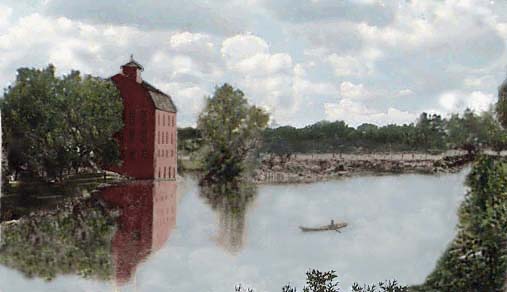|
Grist Mill History
|
It has long been part of local lore that the mill inspired the old song "Down By the Old Mill Stream," based on the fact that the song's composer, Tell Taylor, spent part of his youth in Hobart. George Earle's development of Hobart began with the construction of the grist mill, which opened in 1847. In order to provide water power, he built an earthen dam across Deep River just above the mill, thus creating the mill pond we know as Lake George. Earle sold the mill in 1854 to William Watkins, who owned it only a short time. Other early owners included John Braun (or Brown), William Henderson, William Ballantyne, and Dorman Smith and his son, Sela Smith. By the early 1890's Jarvis and Owen Roper had joined the Smiths to form the partnership of Smith and Roper. In addition to milling, the partners dealt in grain, feed, and coal. Around 1909 Sela Smith was succeeded by Milton and Frank Brown. The Roper and Brown partnership lasted for over 35 years. Although the importance of the milling flour declined in the 20th century as commercial flour became available, in 1946 the mill was still producing buckwheat and whole wheat flour and a "highly-favored old-fashion corn meal." In the early '20s, the mill converted to electricity and abandonded water power entirely. The city of Hobart bought the dam and water rights in order to repair the dam and maintain the water level in the lake. This was an important first step in the continuing process of beautifying Lake George. In 1947 the Lake County Farm Bureau took over the mill. Ralph Kaufman of Leroy purchased it in 1952, doing business as Hoart Coal and Feed and using the old mill only as a storehouse for feed. On Sunday evening, Feb. 15, 1953, a spectacular fire consumed the century-old landmark. Six area fire departments fought the blaze, which was fanned by high winds, that showered sparks all over the city and the hundereds of spectators who gathered to watch the end of the mill.
Although firefighters managed to save the other buildings in the mill complex
and prevent the fire from spreading to three neighboring houses and two nearby
gasoline stations, the mill was gone. Only its memory lingers on. -- By Elin
Christianson, Hobart Historical Society. |
